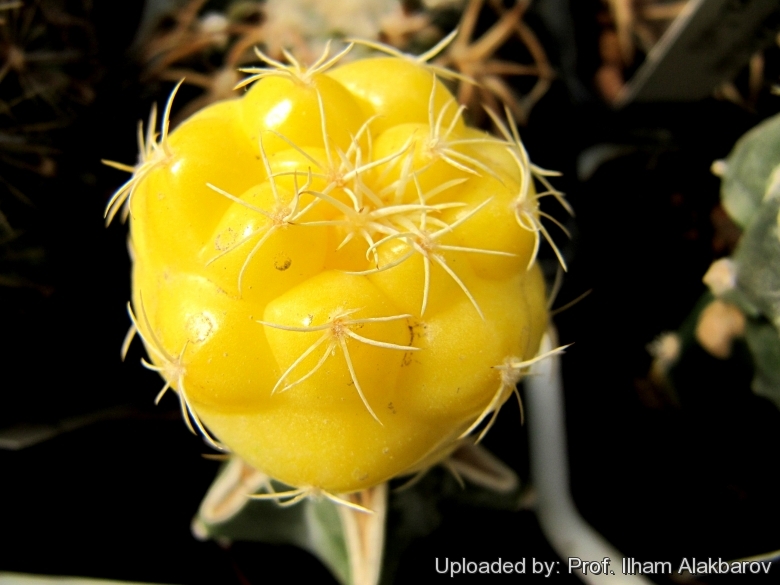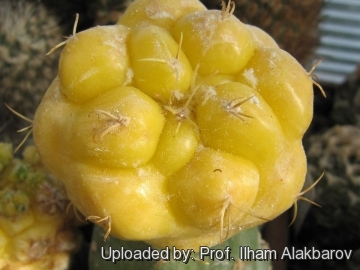Accepted Scientific Name: Coryphantha elephantidens (Lem.) Lem.
Cactées 35. 1868

Coryphantha elephantidens f. aurea Photo by: Prof. Ilham Alakbarov
Origin and Habitat: Garden origin (Nursery produced cultivar)
Synonyms:
See all synonyms of Coryphantha elephantidens
Description: Coryphantha elephantidensSN|26102]]SN|3920]] is a large, depressed-globular cactus, often clumping and group-forming.
Forma aurea or aurata (yellow form): The schizochromic form (Coryphantha elephantidens f. aureaSN|3920]]SN|26102]] ) has yellow stems due to the absence (or reduced production) of chlorophyll pigments: every other pigment is present at normal levels, the dominant green colouration is lost, but will still more than likely have normal other pigments that give the yellow overall appearance of the stem. This form with yellow stems is very attractive and highly prized. This schizochromic form is almost always seen grafted on stronger columnar species, and cannot can be grown on its own roots.
Stems: Cream-yellow to bright golden yellow, up 18 cm in diameter, very large tubercles 20-30 (60) mm wide, rounded on top, pentaedrical at the base, always broader than rounded, without glands, the tubercles axil is woolly.
Spines: The tubercles are capped with a 5-8 of stout reflexed radial spines, long (18-26 mm) never porrect, but adpressed to the body.
Flowers: Sweet smelling large 6 to 7.5 cm whitish to pink-coloured (Or yellow) are produced in late summer to autumn. Very big, fruits are long (ca. 4 cm long, 1 cm diameter)
Subspecies, varieties, forms and cultivars of plants belonging to the Coryphantha elephantidens group
 Coryphantha elephantidens (Lem.) Lem.: Large, depressed-globular cactus, often clumping with large dark-green tubercles rounded on top, the tubercles axil is very woolly. The radial spines are stout reflexed and adpressed to the body. Flowers whitish, yellow or pink.
Coryphantha elephantidens (Lem.) Lem.: Large, depressed-globular cactus, often clumping with large dark-green tubercles rounded on top, the tubercles axil is very woolly. The radial spines are stout reflexed and adpressed to the body. Flowers whitish, yellow or pink. Coryphantha elephantidens f. aurea hort.: Mutant lacking chlorophyll pigment. The result is a completely cream-yellow or golden-yellow plant.
Coryphantha elephantidens f. aurea hort.: Mutant lacking chlorophyll pigment. The result is a completely cream-yellow or golden-yellow plant.- Coryphantha elephantidens var. barciae L.Bremer: It has a big tap-root. Parastichy number 8/13.
 Coryphantha elephantidens subs. bumamma (Ehrenb.) Dicht & A.Lüthy: Strongly offsetting species forming large groups up to 50 cm in diameter. Stem glaucous green. It is very similar to Coryphantha elephantidens but the flower are much smaller and nearly yellow.
Coryphantha elephantidens subs. bumamma (Ehrenb.) Dicht & A.Lüthy: Strongly offsetting species forming large groups up to 50 cm in diameter. Stem glaucous green. It is very similar to Coryphantha elephantidens but the flower are much smaller and nearly yellow.- Coryphantha elephantidens subs. greenwoodii (Bravo) Dicht & A.Lüthy: Solitary or group-forming, flat-globose mostly under the ground-level, intermediate between Coriphantha elepantidens and Coriphantha pycnacantha.
- Coryphantha elephantidens var. recurvispina (de Vriese) hort., nov. comb. ined.: Solitary, depressed, about 16 cm. in diameter, tubercles few, large, glaucous, obtuse; areoles and axils naked ; spines all radial, 8 more or less incurved. ( = Coryphantha elephantidens)
- Coryphantha elephantidens var. roseiflora Y.Itô: Pink flowering form.
 Coryphantha elephantidens subs. sulcolanata (Lem.) hort., nov. comb. ined.: Very similar (if not the same plant) to Coryphantha elephantidens but the flowers are always yellow and never pink. Origin: Hidalgo.
Coryphantha elephantidens subs. sulcolanata (Lem.) hort., nov. comb. ined.: Very similar (if not the same plant) to Coryphantha elephantidens but the flowers are always yellow and never pink. Origin: Hidalgo. Coryphantha elephantidens f. variegata hort.: Variegated form. The stems have sectors, patches or stripes with two colours, yellow and green. There are several forms of variegation.
Coryphantha elephantidens f. variegata hort.: Variegated form. The stems have sectors, patches or stripes with two colours, yellow and green. There are several forms of variegation.  Coryphantha elephantidens cv. Tanshi Zougemaru: Cultivar with short but strong spines and very large tubercles. Flowers pink. Origin: Japan.
Coryphantha elephantidens cv. Tanshi Zougemaru: Cultivar with short but strong spines and very large tubercles. Flowers pink. Origin: Japan. Coryphantha elephantidens cv. Tanshi Zougemaru inermis
Coryphantha elephantidens cv. Tanshi Zougemaru inermis Coryphantha garessii L.Bremer: Probable synonym of Coryphantha elephantides. Origin: Zacatecas
Coryphantha garessii L.Bremer: Probable synonym of Coryphantha elephantides. Origin: Zacatecas
Bibliography: Major references and further lectures
1) Edward Anderson “The Cactus family” Timber Press, Incorporated, 2001
2) James Cullen, Sabina G. Knees, H. Suzanne Cubey "The European Garden Flora Flowering Plants: A Manual for the Identification of Plants Cultivated in Europe, Both Out-of-Doors and Under Glass" Cambridge University Press, 11/Aug/2011
3) David R Hunt; Nigel P Taylor; Graham Charles; International Cactaceae Systematics Group. "The New Cactus Lexicon" dh books, 2006
4) Hernández, H.M., Gómez-Hinostrosa, C., Guadalupe Martínez, J., Sánchez , E., Dicht, R.F. & Lüthy, A.D. 2013. Coryphantha elephantidens. In: IUCN 2013. "IUCN Red List of Threatened Species." Version 2013.2. <www.iucnredlist.org>. Downloaded on 17 February 2014.
 Coryphantha elephantidens f. aurea Photo by: Prof. Ilham Alakbarov
Coryphantha elephantidens f. aurea Photo by: Prof. Ilham AlakbarovSend a photo of this plant.The gallery now contains thousands of pictures, however it is possible to do even more. We are, of course, seeking photos of species not yet shown in the gallery but not only that, we are also looking for better pictures than those already present.
Read More... Cultivation and Propagation: Variegated and albinos cacti are regarded as choice and difficult in cultivation, but despite that many of them are relatively easy to grow. But be aware that they cannot tolerate prolonged exposure to direct sun light (especially during the hottest summer days), so grow them in half-shade or under filtered sun. They are sometime seen as grafted plants, but many grow well on their own roots, too.
On the contrary, the albinos can survive only if grafted on a strong green base.
Use mineral well-permeable substratum with little organic matter (peat, humus). Water sparingly from March till October and keep perfectly dry in winter at temperatures from 5 to 15 degrees centigrade. (In general these plants are more tender and cannot endure freezing temperatures ) In the rest period no high atmospheric humidity!!
Propagation: Plants are usually grafted onto a more vigorous and easier columnar stock.











